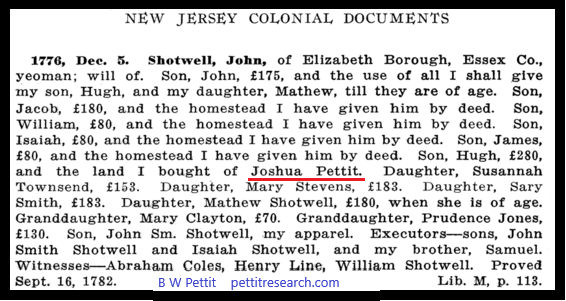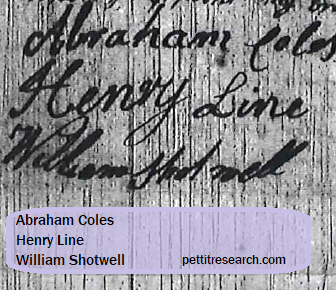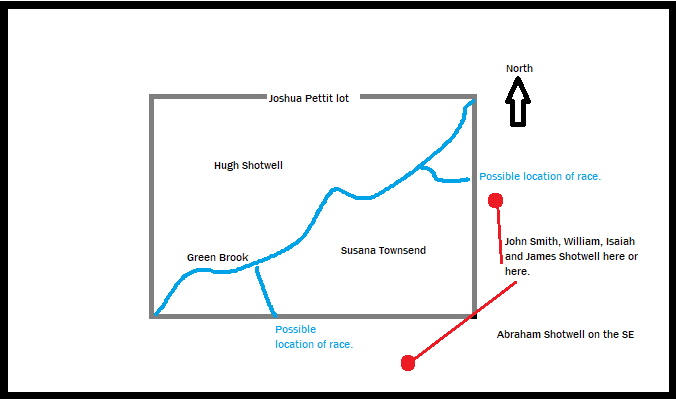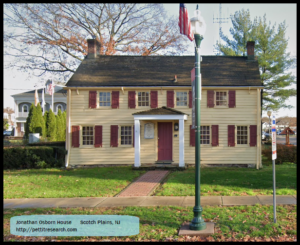Joshua Pettit of Essex Co., NJ: The Land (Part I)
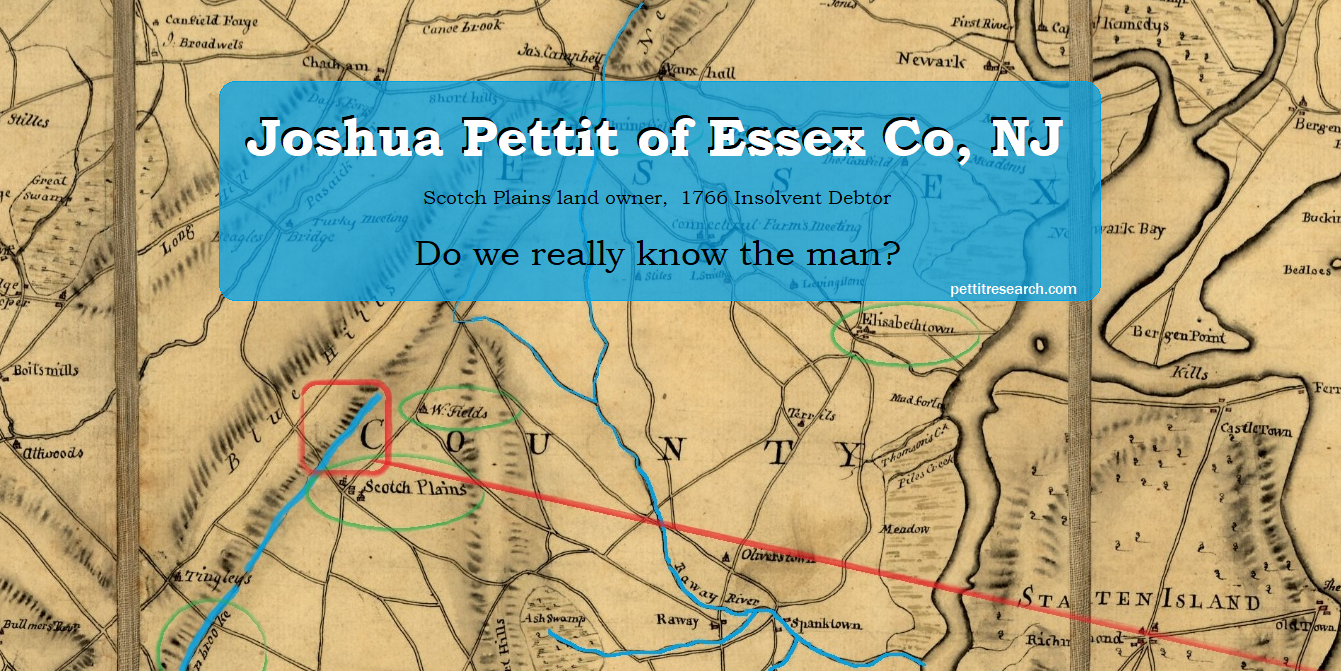
Finding the Joshua Pettit Land in Essex Co., NJ
The precise location of Joshua Pettit’s land in Essex County, New Jersey has long been a mystery. In this article we will attempt to determine where his land was relative to the geography of the 1700’s and where it can be found today.
At the time of this writing on August 31, 2021, there are only four known sources which show that a Joshua Pettit was in Essex Co., NJ. To wit:
- A record of a Joshua Petitt and Thomas Baker who inventoried the estate of a deceased soldier named Oliver Cushman in 1759. (see below)
- A reference to a Joshua Pettit who sold land to John Shotwell in the will of Shotwell. (see below)
- A legal notice for a Joshua Pettit’s financial insolvency that appeared in newspapers on January 23, 1766. (discussed later)
- Another legal notice of a similar nature that appeared in newspapers on August 6, 1767. (discussed later)
For years, researchers have circulated these four records as evidence of a Joshua Pettit’s presence in Essex Co, NJ. These records, as shared by family researchers, are taken from some very old yet very helpful genealogy books. The two newspaper extracts from 1766 and 1767 appear to be complete transcriptions. The primary sources for these do not contain additional information.
However, upon examination of the primary sources for each of the wills, it was discovered that there is important additional information found in the complete will of John Shotwell that did not make the abstract. Researchers are advised that this will is not available online or on public microfilm. It can only be ordered from the New Jersey State Archives or viewed there in person –a process that is time consuming as well as somewhat costly. There are several pages to these records but we will just cover those germane to the goal of this paper.
The Will of John Shotwell of Essex Co., NJ
The will is found in the New Jersey Archive in Volume M p133 for Essex Co. and with the same county probate papers in File 5511-5512G. The will appears to be an actual copy of the original will bearing the true signatures of the testator and witnesses as seen below:
It was John Shotwell’s desire that his land which was purchased from Joshua Pettit was to be divided into two parcels and given to two children. The first recipient was Hugh Shotwell. A copy of this item from the will is seen below:
TRANSCRIPTION:
I give and bequeath to my son Hugh Shotwell the sum of four hundred and eighty pounds money and eight shillings moveable estate in money… and likewise all that loot [sic] of land that I purchased of Joshuay Pettit [sic, Joshua Pettit] that lies on the North West side of Green Brook to him his heirs and assigns forever and not any part that lays the south east of Green Brook the money and lands to remain in the hand of my executor till he arrives to a lawful age.
The second recipient was Susana (Shotwell) Townsend:
TRANSCRIPTION: I give and bequeath to my daughter Susana Townsend the sum of one hundred and fifty three[?] ponds money at eight shillings per ounce to be paid to her out of my moveable estate in money or such pounds as I have and likewise all the remaining part of that land I purchased of Joshuay Pettit [sic, Joshua Pettit] that lays the east side of Green Brook binding south east from Abraham Shotwell northeast upon Green Brook to him his [sic, her her] heirs and assigns forever but the race that is cut through the place to fetch a stream of water out of green brook for the use of John Sm Shotwell, William Shotwell, Isaiah Shotwell and James Shotwell is to be no way stopt or damaged by the said Townsend nor any other person.
This will was written in 1776 but not proved until 1782.
Analyzing the Info in the John Shotwell Will
From the will we can make several statements of fact about the old Pettit land:
- John Shotwell purchased the land from Joshua Pettit sometime before the will was penned on December 5, 1776.
- The land John Shotwell purchased of Joshua Pettit was on both sides of a stream called Green Brook.
- The portion that was given to his minor son Hugh Shotwell was on the north west side of Green Brook.
- The land given to his daughter Susana Townsend was on the east side of Green Brook.
- Susana Townsend’s Joshua Pettit tract was bounded by land owned by Abraham Shotwell on the south east.
- The Pettit tract also had an irrigation ditch cut through it which supplied water to John Smith Shotwell, William Shotwell, Isaiah Shotwell and James Shotwell who presumably lived nearby and east of Green Brook.
With this info we can roughly sketch out the lay of the lot. (For this illustration we will use a rectangular lot but it may very well have been an irregular shape.)
Where was his land on Green Brook? And for that matter, where is Green Brook?
Clues from the Newspapers
The newspaper notices for the creditors of Joshua Pettit in 1766 and 1767 also yield some precious details. We will go over this information in detail in the next article but one important clue deserves our immediate attention. The last notice issued on August 6, 1767 states:
“This is to Notify the Creditors of Joshua PETTIT, an insolvent debtor, to meet at the House of Mr. Jonathan Osborne, at the Scotch-Plains, in the Borough of Elizabeth, East New- Jersey, on Thursday the 20th of August, Instant; when and where, the Assignees of said PETTIT, will attend to settle with said Creditors. Scotch-Plains, Borough of Elizabeth, East N. Jersey.” – [Source: The New York Journal or General Advertiser, No. 1283, August 6, 1767.]
From the newspaper notices we can state the following information with some degree of confidence:
- The creditors of Joshua Pettit were ordered to meet with his assignee at the house of Jonathan Osborn at the Scotch Plains, in the Borough of Elizabeth.
It can be reasonably inferred that the meeting at the Osborn house was to accommodate creditors of Joshua Pettit who lived around an area known as the Scotch Plains. Joshua Pettit’s property was therefore likely in the area of Green Brook that flowed through the Scotch Plains. The loose boundaries of Scotch Plains in 1767 contrasted with the tight municipal fence lines of Scotch Plains today make the task of locating the land somewhat difficult. We need a historical anchor point –a way marker that geographically ties the story of hard times, debts, and land sales of the past to the present day. We have such a monument.
The Johnathan Osborn House
Amazingly, the house of Jonathan Osborn in Scotch Plains is still standing. It is actually open to the public as a museum and is called the “Osborn Cannonball House.” The odd nickname originates from the time of the American Revolution when a carelessly fired cannonball found its way into one of the walls of the house. The New Jersey Historical Society believes the house was built sometime in the 1760s. Today it can be found at 1840 Front Street, Scotch Plains, NJ and is seen below.
It was at this house that the creditors of Joshua Pettit met with his assignees to settle his debts. A careful reading of the newspaper notice will reveal what at first may seem to be an inconsequential point. This meeting was to be held with the creditors and assignees only. Joshua Pettit was not present. This begs the question, where was he? Was he deceased? Had he already migrated to Hampshire Co. in Virginia or 96 District in South Carolina? The answer to these questions lies in an unexpected place –the text of the “Act for the Relief of Insolvent Debtors”. And even more unexpected is the answer itself.
Conclusion
Those are the first set of hints to ponder as we attempt to pin down the location of the Joshua Pettit’s New Jersey land. In the next article we will add some more interesting historical details about the insolvent debtor laws and identify some other important characters who may have lived nearby.
Next in this series: Joshua Pettit of Essex Co., NJ: The Insolvent Debtor.

